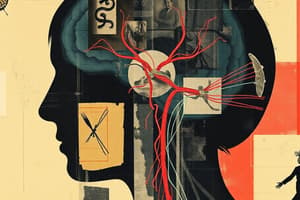Podcast
Questions and Answers
What type of tactile receptor is known for responding best to indentation?
What type of tactile receptor is known for responding best to indentation?
- SA1 - Merkel cells (correct)
- SA 2
- FA 2 - Pacinian corpuscles
- FA 1 - Meissner corpuscles
Which receptor would be best suited for perceiving fine textures through transmitted vibration?
Which receptor would be best suited for perceiving fine textures through transmitted vibration?
- SA 2 receptors
- FA1 - Meissner corpuscles
- SA1 - Merkel cells
- FA2 - Pacinian corpuscles (correct)
Which of the following statements about spatial resolution is correct?
Which of the following statements about spatial resolution is correct?
- Spatial resolution is irrelevant to tactile sensations.
- Higher thresholds equate to better spatial awareness.
- The thigh has a high resolution due to a low threshold.
- Fingers can discriminate two points due to high receptor density. (correct)
What type of mechanoreceptor is identified as responding predominantly to skin stretch?
What type of mechanoreceptor is identified as responding predominantly to skin stretch?
How do slowly adapting (SA) tactile receptors differ from rapidly adapting (FA) receptors?
How do slowly adapting (SA) tactile receptors differ from rapidly adapting (FA) receptors?
Which tactile receptor is primarily responsible for maintaining grip control?
Which tactile receptor is primarily responsible for maintaining grip control?
Pacinian corpuscles have a small receptive field and are sensitive to pressure.
Pacinian corpuscles have a small receptive field and are sensitive to pressure.
What is the role of Merkel cells in somatosensation?
What is the role of Merkel cells in somatosensation?
The ______ sensation provides information about the external environment through tactile receptors located in the skin.
The ______ sensation provides information about the external environment through tactile receptors located in the skin.
Match the following tactile receptors with their primary characteristic:
Match the following tactile receptors with their primary characteristic:
What is the primary function of proprioceptors in the body?
What is the primary function of proprioceptors in the body?
Which statement best describes a characteristic of joint receptors?
Which statement best describes a characteristic of joint receptors?
Which type of neuron innervates Golgi tendon organs?
Which type of neuron innervates Golgi tendon organs?
What does the term 'touch physiology' primarily refer to?
What does the term 'touch physiology' primarily refer to?
What role does tactile spatial attention play in sensory processing?
What role does tactile spatial attention play in sensory processing?
What is the primary function of nociceptors in the skin?
What is the primary function of nociceptors in the skin?
What type of fibers are classified as C-fibers?
What type of fibers are classified as C-fibers?
Which receptor is activated by menthol, providing a cold sensation?
Which receptor is activated by menthol, providing a cold sensation?
What role does proprioception play in the sensory system?
What role does proprioception play in the sensory system?
Which sensation is described as resulting from an inflammatory response that makes a site of damage more sensitive?
Which sensation is described as resulting from an inflammatory response that makes a site of damage more sensitive?
What condition was suffered by 'Miss C', who was born with insensitivity to pain?
What condition was suffered by 'Miss C', who was born with insensitivity to pain?
What is kinaesthesia often used interchangeably with?
What is kinaesthesia often used interchangeably with?
What aspect of haptic perception involves knowing the location of objects using touch?
What aspect of haptic perception involves knowing the location of objects using touch?
What is the primary function of proprioceptors?
What is the primary function of proprioceptors?
Egocenter refers to the center of a reference frame that is not relative to the body's position.
Egocenter refers to the center of a reference frame that is not relative to the body's position.
What is the primary role of the Golgi tendon organs?
What is the primary role of the Golgi tendon organs?
The __________ experience demonstrates how touch can change one's body image perception.
The __________ experience demonstrates how touch can change one's body image perception.
Match the following proprioceptors with their primary functions:
Match the following proprioceptors with their primary functions:
Which type of fibers is responsible for sensing acute pain in response to harmful stimuli?
Which type of fibers is responsible for sensing acute pain in response to harmful stimuli?
Proprioception refers to the body's ability to detect changes in external temperature.
Proprioception refers to the body's ability to detect changes in external temperature.
What type of pain results from damage to the nervous system?
What type of pain results from damage to the nervous system?
The sensation of cold can be activated by the chemical __________.
The sensation of cold can be activated by the chemical __________.
Match the type of receptor with its corresponding sensation:
Match the type of receptor with its corresponding sensation:
What is the main function of thermoreceptors in the skin?
What is the main function of thermoreceptors in the skin?
Individuals with insensitivity to pain do not experience injury.
Individuals with insensitivity to pain do not experience injury.
What is the primary system that plays a role in the perception of movement of our limbs?
What is the primary system that plays a role in the perception of movement of our limbs?
Which pathway carries signals from pain and thermoreceptors?
Which pathway carries signals from pain and thermoreceptors?
The primary somatosensory cortex is located in the frontal lobe.
The primary somatosensory cortex is located in the frontal lobe.
What is the role of the dorsal root ganglion?
What is the role of the dorsal root ganglion?
The somatosensory map in the primary somatosensory cortex is not proportional to the ________ of the skin innervated.
The somatosensory map in the primary somatosensory cortex is not proportional to the ________ of the skin innervated.
Match the following components with their respective functions:
Match the following components with their respective functions:
The spinothalamic pathway is primarily responsible for transmitting information about fine touch and vibration.
The spinothalamic pathway is primarily responsible for transmitting information about fine touch and vibration.
What type of sensory receptors are located at the interface between the extrafusal muscle fibers and the tendon?
What type of sensory receptors are located at the interface between the extrafusal muscle fibers and the tendon?
The ______ system is responsible for maintaining the optimal length of muscle spindles during muscle contraction.
The ______ system is responsible for maintaining the optimal length of muscle spindles during muscle contraction.
Match the following types of receptors with their respective functions:
Match the following types of receptors with their respective functions:
Which pathway is involved in carrying information about pain, temperature, and crude touch?
Which pathway is involved in carrying information about pain, temperature, and crude touch?
Tactile agnosia refers to the difficulty in identifying objects through vision.
Tactile agnosia refers to the difficulty in identifying objects through vision.
What term is used to describe the representation of the body in relation to the area of skin and the cortex that represents it?
What term is used to describe the representation of the body in relation to the area of skin and the cortex that represents it?
Flashcards
Tactile Receptors
Tactile Receptors
Specialized nerve endings in the skin that detect mechanical stimuli like pressure and vibration.
Merkel Cells
Merkel Cells
Tactile receptors that respond to indentation and provide high spatial resolution for perceiving details like texture and shape.
SA 2 Receptors
SA 2 Receptors
Tactile receptors that respond to skin stretch and provide information about the overall shape and position of the hand.
Meissner Corpuscles
Meissner Corpuscles
Signup and view all the flashcards
2-point discrimination
2-point discrimination
Signup and view all the flashcards
What does transduction mean in touch?
What does transduction mean in touch?
Signup and view all the flashcards
What are the two main types of adaptation for tactile receptors?
What are the two main types of adaptation for tactile receptors?
Signup and view all the flashcards
What is the difference between spatial and temporal resolution?
What is the difference between spatial and temporal resolution?
Signup and view all the flashcards
What do Pacinian Corpuscles do?
What do Pacinian Corpuscles do?
Signup and view all the flashcards
What is the relationship between receptor density and 2-point discrimination?
What is the relationship between receptor density and 2-point discrimination?
Signup and view all the flashcards
Frame of Reference (Touch)
Frame of Reference (Touch)
Signup and view all the flashcards
Egocenter
Egocenter
Signup and view all the flashcards
Body Image
Body Image
Signup and view all the flashcards
Rubber-Hand Illusion
Rubber-Hand Illusion
Signup and view all the flashcards
Tactile Spatial Attention
Tactile Spatial Attention
Signup and view all the flashcards
Thermoreceptors
Thermoreceptors
Signup and view all the flashcards
What are the two main types of sensory fibers for pain?
What are the two main types of sensory fibers for pain?
Signup and view all the flashcards
What is hyperalgesia?
What is hyperalgesia?
Signup and view all the flashcards
What is neuropathic pain?
What is neuropathic pain?
Signup and view all the flashcards
What is proprioception?
What is proprioception?
Signup and view all the flashcards
What is the difference between interoception and proprioception?
What is the difference between interoception and proprioception?
Signup and view all the flashcards
What is haptics?
What is haptics?
Signup and view all the flashcards
What is Kinaesthesia?
What is Kinaesthesia?
Signup and view all the flashcards
Warm fibers
Warm fibers
Signup and view all the flashcards
Cold fibers
Cold fibers
Signup and view all the flashcards
Nociception
Nociception
Signup and view all the flashcards
C-fibers
C-fibers
Signup and view all the flashcards
A-delta fibers
A-delta fibers
Signup and view all the flashcards
Proprioception
Proprioception
Signup and view all the flashcards
Kinaesthesia
Kinaesthesia
Signup and view all the flashcards
What is a frame of reference (touch)?
What is a frame of reference (touch)?
Signup and view all the flashcards
What is egocenter (touch)?
What is egocenter (touch)?
Signup and view all the flashcards
What is body image (touch)?
What is body image (touch)?
Signup and view all the flashcards
What are proprioceptors?
What are proprioceptors?
Signup and view all the flashcards
How do muscle spindles work?
How do muscle spindles work?
Signup and view all the flashcards
Spinal Cord Structure
Spinal Cord Structure
Signup and view all the flashcards
Dorsal Column-Medial Lemniscal Pathway
Dorsal Column-Medial Lemniscal Pathway
Signup and view all the flashcards
Spinothalamic Pathway
Spinothalamic Pathway
Signup and view all the flashcards
Somatosensory Cortex Map
Somatosensory Cortex Map
Signup and view all the flashcards
Dorsal and Ventral Pathways
Dorsal and Ventral Pathways
Signup and view all the flashcards
Haptic Perception
Haptic Perception
Signup and view all the flashcards
Perception for Action
Perception for Action
Signup and view all the flashcards
Exploratory Procedure
Exploratory Procedure
Signup and view all the flashcards
Haptic Search
Haptic Search
Signup and view all the flashcards
Tactile Agnosia
Tactile Agnosia
Signup and view all the flashcards
Muscle Spindles
Muscle Spindles
Signup and view all the flashcards
Golgi Tendon Organs
Golgi Tendon Organs
Signup and view all the flashcards
Joint Receptors
Joint Receptors
Signup and view all the flashcards
Study Notes
Somatosensation: Body Sensation
- Somatosensation is the sense of the body. Touch is a component of somatosensation.
- Touch is the process of converting mechanical energy into signals in the skin. This is called transduction.
- Exteroception is the sense of the external world.
Tactile Receptors
- Tactile receptors are located in the skin.
- Mechanoreceptors are located in the dermis (beneath the epidermis)
- Tactile receptors are classified based on:
- Type of stimuli they respond to
- Size of their receptive field
- How quickly they adapt (rapidly or slowly).
- Some receptors fire continuously while the stimulus is present (slow adaptation). Others only fire at the start and end of the stimulus (fast adaptation). Fast adapting receptors are good at detecting changes in touch.
- Mechanoreceptors respond to pressure, vibration, and movement.
Mechanoreceptor Types
-
Merkel cells (SA 1)
- Respond best to indentation
- Small receptive field
- High spatial resolution (good at discerning fine details), low temporal resolution (not good at detecting rapid changes).
- Close to the skin surface.
- Used to perceive pattern, texture, and shape.
-
Ruffini endings (SA 2)
- Respond best to stretch.
- Large receptive field
- Low spatial resolution, low sensitivity to temporal variations.
- Deeper in the dermis than Merkel cells.
- Used to perceive skin stretch and hand conformation.
-
Meissner corpuscles (FA 1)
- Respond best to skin movement.
- Small receptive field
- High spatial resolution, medium temporal resolution.
- Close to the skin surface.
- Used to perceive slip, and maintain grip control.
-
Pacinian corpuscles (FA 2)
- Respond best to vibration.
- Large receptive field
- Low spatial resolution, high temporal resolution.
- Deeper in the dermis.
- Used to perceive fine textures through vibrations.
Spatial and Temporal Resolution
- Spatial Threshold: The ability to distinguish two separate points of touch.
- This ability depends on the density of receptors and their location.
- Fingers have a low threshold (high spatial resolution) and thighs have a high threshold (low spatial resolution).
- Temporal Resolution: How quickly the system can detect changes in touch.
- Touch has a relatively fast temporal resolution (5 milliseconds).
- Vision has a slower temporal resolution (25 milliseconds).
Studying That Suits You
Use AI to generate personalized quizzes and flashcards to suit your learning preferences.
Description
Explore the fascinating world of somatosensation, focusing on how our body perceives touch through various tactile receptors. Learn about the different types of mechanoreceptors and their functions in detecting changes in our environment. This quiz delves into the intricacies of body sensation and the mechanisms behind our sense of touch.




